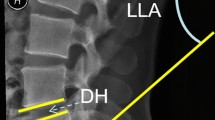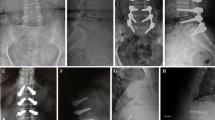Abstract
Purpose
To describe and analyze the use of the V-rod technique described by Gillet to repair spondylolysis in both early and late postoperative periods.
Methods
Patients submitted to surgical correction of lumbar spondylolysis with a V-rod system were selected upon exclusion of adjacent disk degenerative changes and high-grade spondylolisthesis. A preoperative clinical (ODI and VAS) and radiological evaluation was performed, along with assessments on the early (clinical evaluation—up to 1 year) and late (clinical and radiological—at least 10 years) postoperative periods.
Results
Twenty-two patients were included, 21 with L5 spondylolysis. Fifty percent had grade I spondylolisthesis. A significant decrease in ODI and VAS was observed from pre- to early and late post-op evaluation (all p < 0.05) but not during post-op evaluations. Changes from pre- to postoperative of both ODI and VAS were significantly higher than the minimal clinically important difference. Preoperative ODI and VAS were significantly higher in overweight/obese but similar postoperatively. No additional instability was found in late postoperative X-rays. Three patients needed revision surgery, with a survival rate of 81.8% for Gillet instrumentation at a mean follow-up of 687.7 ± 60.0 weeks.
Conclusions
Surgical treatment with V-rod system is associated with a significant improvement in ODI and VAS and radiologic stability, with an equal benefit in obese/overweight patients. This study reports for the first time an improvement that is maintained even 10 years after the initial intervention, associated with a low rate of failure.
Graphical abstract
These slides can be retrieved under Electronic Supplementary Material.




Similar content being viewed by others
References
Foreman P, Griessenauer CJ, Watanabe K, Conklin M, Shoja MM, Rozzelle CJ, Loukas M, Tubbs RS (2013) L5 spondylolysis/spondylolisthesis: a comprehensive review with an anatomic focus. Childs Nerv Syst 29(2):209–216. https://doi.org/10.1007/s00381-012-1942-2
Wiltse LL, Newman PH, Macnab I (1976) Classification of spondylolysis and spondylolisthesis. Clin Orthop Relat Res 117:23–29
Chen MR, Moore TA, Cooperman DR, Lee MJ (2013) Anatomic variability of 120 L5 spondylolytic defects. Global Spine J 3(4):243–248. https://doi.org/10.1055/s-0033-1356765
Gennari JM, Themar-Noel C, Panuel M, Bensamoun B, Deslandre C, Linglart A, Sokolowski M, Ferrari A (2015) Adolescent spinal pain: the pediatric orthopedist’s point of view. Orthop Traumatol Surg Res 101(6, Supplement):S247–S250. https://doi.org/10.1016/j.otsr.2015.06.012
Yang S, Werner BC, Singla A, Abel MF (2015) Low back pain in adolescents: a 1-year analysis of eventual diagnoses. J Pediatric Orthop. https://doi.org/10.1097/bpo.0000000000000653
Crawford CH III, Ledonio CGT, Bess RS, Buchowski JM, Burton DC, Hu SS, Lonner BSH, Polly DW, Smith JS, Sanders JO (2015) Current evidence regarding the surgical and nonsurgical treatment of pediatric lumbar spondylolysis: a report from the Scoliosis Research Society Evidence-Based Medicine Committee. Spine Deform 3(1):30–44. https://doi.org/10.1016/j.jspd.2014.06.004
Omidi-Kashani F, Ebrahimzadeh MH, Salari S (2014) Lumbar spondylolysis and spondylolytic spondylolisthesis: who should be have surgery? An algorithmic approach. Asian Spine J 8(6):856–863. https://doi.org/10.4184/asj.2014.8.6.856
Fan J, Yu GR, Liu F, Zhao J, Zhao WD (2010) A biomechanical study on the direct repair of spondylolysis by different techniques of fixation. Orthop Surg 2(1):46–51
Gillet P (2005) Isthmic reconstruction with pedicle screws and a V-shaped rod in spondylolysis without degenerative disk disease. In: Gunzburg R, Szpalski M (eds) Spondylolysis, spondylolisthesis, and degenerative spondylolisthesis. Lippincott Williams and Wilkins, Philadelphia, pp 143–152
Lau LL, Shah SA (2015) Surgical techniques: spondylolysis repair. In: Spondylolisthesis: diagnosis, non-surgical management, and surgical techniques, pp 139–148. https://doi.org/10.1007/978-1-4899-7575-1_11
Kimura M (1968) My method of filing the lesion with spongy bone in spondylolysis and spondylolisthesis. Seikeigeka Orthop Surg 19(4):285–296
Nicol RO, Scott JH (1986) Lytic spondylolysis: repair by wiring. Spine 11(10):1027–1030
Hambly MF, Wiltse LL (1994) A modification of the Scott wiring technique. Spine 19(3):354–356
Buck JE (1970) Direct repair of the defect in spondylolisthesis. Preliminary report. J Bone Joint Surg Ser B 52(3):432–437
Morscher E, Gerber B, Fase J (1984) Surgical treatment of spondylolisthesis by bone grafting and direct stabilization of spondylolysis by means of a hook screw. Arch Orthop Trauma Surg 103(3):175–178. https://doi.org/10.1007/BF00435550
Louis R (1988) Pars interarticularis reconstruction for spondylolysis by plate and screws with grafting without arthrodesis. A review of 78 cases. Rev Chir Orthop Reparatrice Appar Mot 74(6):549–557
Gillet P, Petit M (1999) Direct repair of spondylolysis without spondylolisthesis, using a rod-screw construct and bone grafting of the pars defect. Spine 24(12):1252–1256. https://doi.org/10.1097/00007632-199906150-00014
Chen XS, Zhou SY, Jia LS, Gu XM, Fang L, Zhu W (2013) A universal pedicle screw and V-rod system for lumbar isthmic spondylolysis: a retrospective analysis of 21 cases. PLoS ONE 8(5):e63713. https://doi.org/10.1371/journal.pone.0063713
Sairyo K, Goel VK, Faizan A, Vadapalli S, Biyani S, Ebraheim N (2006) Buck’s direct repair of lumbar spondylolysis restores disc stresses at the involved and adjacent levels. Clin Biomech (Bristol Avon) 21(10):1020–1026. https://doi.org/10.1016/j.clinbiomech.2006.06.011
Schwind J, Learman K, O’Halloran B, Showalter C, Cook C (2013) Different minimally important clinical difference (MCID) scores lead to different clinical prediction rules for the Oswestry disability index for the same sample of patients. J Man Manip Ther 21(2):71–78. https://doi.org/10.1179/2042618613Y.0000000028
Parker SL, Mendenhall SK, Shau D, Adogwa O, Cheng JS, Anderson WN, Devin CJ, McGirt MJ (2012) Determination of minimum clinically important difference in pain, disability, and quality of life after extension of fusion for adjacent-segment disease. J Neurosurg Spine 16(1):61–67. https://doi.org/10.3171/2011.8.SPINE1194
Koptan WMT, El Miligui YH, El Sharkawi MM (2011) Direct repair of spondylolysis presenting after correction of adolescent idiopathic scoliosis. Spine J 11(2):133–138. https://doi.org/10.1016/j.spinee.2011.01.012
Hasz MW (2012) Diagnostic testing for degenerative disc disease. Adv Orthop 2012:413913. https://doi.org/10.1155/2012/413913
Brinjikji W, Luetmer PH, Comstock B, Bresnahan BW, Chen LE, Deyo RA, Halabi S, Turner JA, Avins AL, James K, Wald JT, Kallmes DF, Jarvik JG (2015) Systematic literature review of imaging features of spinal degeneration in asymptomatic populations. AJNR Am J Neuroradiol 36(4):811–816. https://doi.org/10.3174/ajnr.A4173
Roca J, Iborra M, Cavanilles-Walker JM, Alberti G (2005) Direct repair of spondylolysis using a new pedicle screw hook fixation: clinical and CT-assessed study: an analysis of 19 patients. J Spinal Disord Tech 18(Suppl):S82–S89
Author information
Authors and Affiliations
Corresponding author
Ethics declarations
Ethical approval
All procedures performed in studies involving human participants were in accordance with the ethical standards of the institutional and/or national research committee and with the 1964 Helsinki declaration and its later amendments or comparable ethical standards. Informed consent was obtained from all individual participants included in the study. This study protocol was submitted to and approved by a central ethics committee.
Conflict of interest
Daniela Linhares, Pedro Cacho Rodrigues, Manuel Ribeiro da Silva, Rui Matos, Vitorino Veludo, Rui Pinto and Nuno Neves declare no conflict of interests.
Electronic supplementary material
Below is the link to the electronic supplementary material.
Rights and permissions
About this article
Cite this article
Linhares, D., Cacho Rodrigues, P., Ribeiro da Silva, M. et al. Minimum of 10-year follow-up of V-rod technique in lumbar spondylolysis. Eur Spine J 28, 1743–1749 (2019). https://doi.org/10.1007/s00586-018-5833-4
Received:
Accepted:
Published:
Issue Date:
DOI: https://doi.org/10.1007/s00586-018-5833-4




